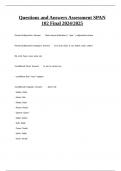Russia Source questions -
Model answer 23/25 -
The sources overall support the statement to a large extent. The
first two sources do suggest a will to improve the issues that
incited the revolution, however, it seems this may have been an
attempt to simply preserve the Tsar’s position than to truly address
the problems. The later two sources, which illustrate many of the
compromises have actually failed to be implemented suggests
there was never an intent to fix problems. Therefore, it can be
argued the sources largely support the claim that there was no
intention of addressing issues as even though it appears there is
some effort to bring in helpful measures, it could be argued this
was purely to allow the Tsarist regime to survive and there was no
real intent to fix the issues that caused the revolution.
Source A at first suggests there was an intention of addressing the
problems that caused the revolution. It first refers to ‘measures’
that will be taken to ‘stop disorders’, implying the regime is willing
to take some form of action. There is also an extensive list of rights
given in the source, such as ‘freedom of…speech, assembly,
union’ suggesting the regime was willing to grant demands of the
people, as they called for more freedom, implying they were willing
to take action against the problems that caused the revolution. It
was these demands that had resulted in the people going to Winter
Palace, and so the Tsar granting their wishes suggests there was
an intent to fix issues. There is also a mention of the Duma being
established and playing a significant role within Russian politics,
stating ‘no rule shall go into force without the Duma’. This is
emphasised by the fact this rule is stated to be ‘unbreakable’
implying the Tsar had an intention to permanently alter how the
country operated. There is a sense, however, that things may not
completely change as there is still a mention of the Tsar’s power
throughout the source with references to ‘we’ and ‘Us’ that suggest
a reluctancy to abandon autocracy. This hesitancy to make
concessions suggests there may have been little intention to
properly address issues, but rather temporary promises to allow
the regime to survive.
It is the provenance that allows us to infer there may have been
very little intent to actually fix issues. The October Manifesto was
, written to appease the people and put an end to the revolution. The
regime was threatened as the revolution worsened, though there
had been unrest since January the number of strikes increased
from September, which pushed the Tsar to end the disorder. A
strike that had begun in Moscow in September by railway workers
that had turned into a general strike with almost 2 million from
many areas of employment taking part had particular impact as
cities and towns began to run out of food and medical supplies.
This level of disorder meant the Tsar’s position was not secure and
so he needed to take action. The Tsar had wanted to put down the
Revolution with more violent methods, however was convinced by
advisors such as Witte to do so peacefully by meeting the
demands of the people. The Manifesto, which contained many
concessions such as freedom of speech and an elected Duma,
was largely successful, as the liberals and middle class felt their
aims had been met and so the revolution came to a halt. The Tsar’s
reluctancy to abandon his autocratic principles however, may
illustrate there was very little intent to fix the problems that caused
the revolution, and that the October Manifesto was merely a
temporary way to secure his position. It can also be said the
source is reliable as it accurately represents what was being
attempted at the time.
Source B similarly suggests there are measures being taken to
address the issues that caused the revolution stating there is an
aim to ‘better’ conditions for peasants. This is emphasised as it is
stated this will ‘permanently’ improve their welfare, suggesting this
is not something which the Tsar is doing to secure his position
again, but a genuine effort to fix issues within Russia. This was to
be done by reducing and eventually discontinuing ‘payments due
from peasants for land’, as well as improving the Peasant Land
Bank in an attempt to reassure and win support from peasants.
This manifesto simply added to the October Manifesto, hoping to
appease the peasants who had originally not been included. We
therefore can come to a similar conclusion that this was an attempt
to secure the Tsar’s position by showing a will to compromise, in
this instance to the peasants, rather than perhaps a genuine effort
to fix issues. During June to July of 1905 there had been a number
of peasant uprisings, including incidents such as burning landlord’s





